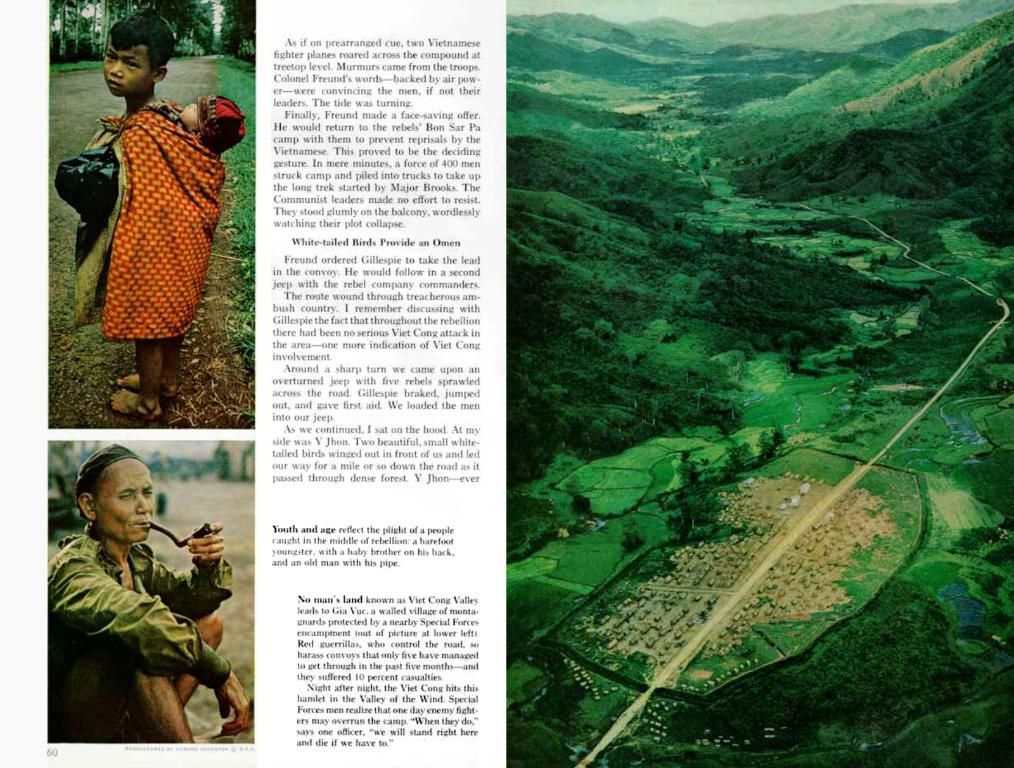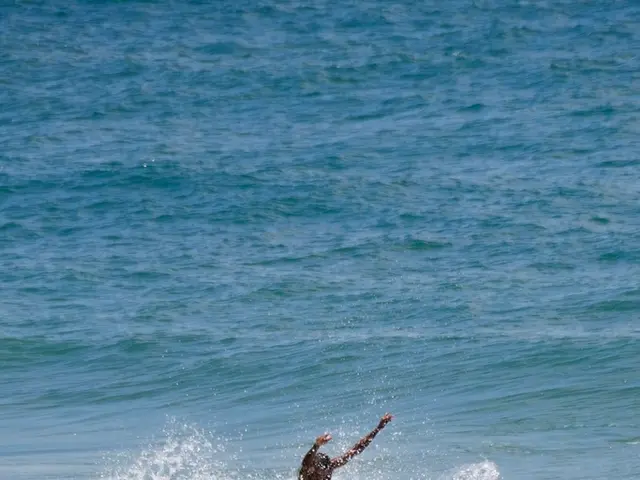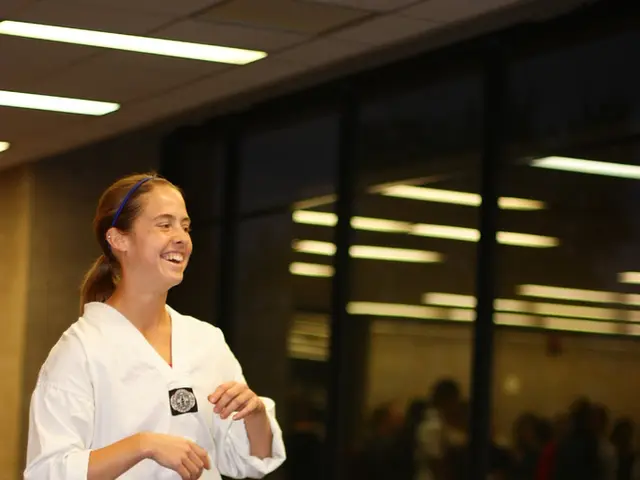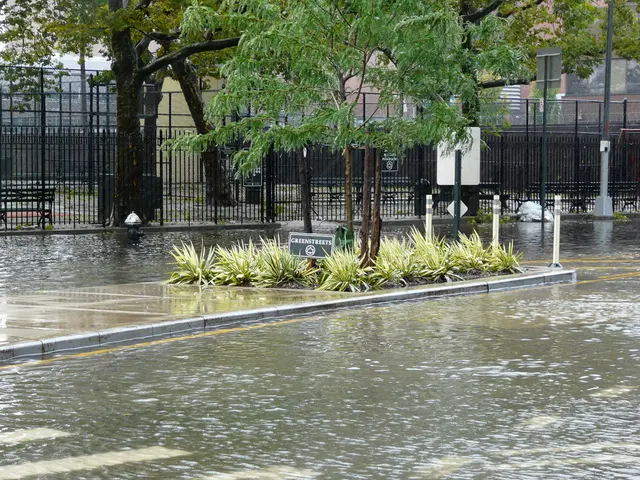Skydance Over Guadalcanal: A Fierce Aerial Battle between Southerland and Sakai
Intense Aerial Combat in Guadalcanal, 1942: Duel in the Sky Between US Aviator Southerland and Japanese Pilot Sakai
Summer 1942 marked a blazing, heated contest in the skies above Guadalcanal, as two airborne warriors found themselves in a dogfight that would etch itself in military history. On August 7, 1942, over the advancing frontline of this beleaguered island, Captain James "Pug" Southerland, a 30-year-old American fighter pilot, clashed with Petty Officer First Class Saburo Sakai, a 25-year-old Japanese ace and rising star in the Imperial Japanese Navy Air Service, each piloting their respective deadly machines.
Let's delve deeper into the drama that unfolded in the crucible of the Pacific War.
Guadalcanal: The Sanctum of War's Raging Theatre
The stage for this aerial duel was set amid the Guadalcanal Campaign, a monumental struggle in the Pacific Theater. Following Japan's aggressive expansion, the U.S. launched Operation Watchtower in August 1942, with the aim of capturing the island's vital airfield.
Guadalcanal's ground and aerial conflicts garnered a chilling renown, drawing both Japanese and American forces into an unrelenting conflict. The skies above the island became a battleground for control, with daily dogfights transforming the tropical sky into a deadly combat zone.
The Contenders: A Wildcat vs. a Zero
On August 7th, Southerland and his fellow Wildcat pilots took to the skies under the command of Fighter Squadron VF-5 onboard the aircraft carrier USS Saratoga. Their mission was to protect Allied forces during the island's initial invasion.
Captain James "Pug" Southerland:
- Age: 30
- Aircraft: Grumman F4F Wildcat
- Experience: Skilled naval aviator with previous combat experience
- ** strengths:** Exceptional gunnery skills and tactical awareness
Petty Officer First Class Saburo Sakai:
- Age: 25
- Aircraft: Mitsubishi A6M Zero
- Experience: Numerous confirmed kills
- ** strengths:** Fierce maneuverability, precision shooting, and relentless spirit
Their aircraft juxtaposed in design and capability.
The Grumman F4F Wildcat:
- Slower and less maneuverable but reinforced armor
- Gun armament: Four powerful .50 caliber machine guns
- Endurance: Able to sustain damage and continue flying
The Mitsubishi A6M Zero:
- Faster and far more agile, with exceptional climb and turning capabilities
- Armor: Lightweight for its class, leaving it vulnerable in prolonged engagements
- Gun armament: Two devastating 20mm cannons and two rapid-fire 7.7mm machine guns
The Dance of Destiny: A Fatal Tango between Two Aces
As the Guadalcanal invasion began, Japanese Zeroes descended to intercept American air cover. Southerland and his Wildcat comrades engaged the incoming adversaries. In the tumultuous melee, Southerland was separated from his squadron, drawing the wrath of one of Japan’s deadliest pilots – Saburo Sakai.
The Initial Exchange:
Spotting Sakai's Zero barreling toward him, Southerland dared a head-on attack, unleashing the full fury of his .50 caliber machine guns. Despite the Zero's advantage in speed, Southerland's skillful aim sent Sakai retreating to regroup.
A Duel in the Sun:
The two adversaries circled each other, climbing and diving through the clouds, pushing their machines beyond their limits. Sakai's Zero, with its impressive agility, repeatedly gained the upper hand, pursuing Southerland relentlessly. Yet, Southerland's Wildcat, though slow in comparison, demonstrated remarkable resilience.
Tacticalfiness:
As the duel intensified, Sakai's seemingly unstoppable Zero targeted Southerland's Wildcat, hammering it with machine-gun fire. Despite the damage, Southerland executed brilliant evasive maneuvers, skillfully dodging Sakai's onslaught.
Close Shaves:
In a dramatic and near-fatal moment, Sakai hit Southerland's Wildcat with directly aimed shots, igniting multiple parts of the aircraft. The damage was critical, but Southerland's courage and piloting skills kept the crippled aircraft aloft. Eventually, however, he was forced to abandon his plane and parachute into the Pacific.
The Aftermath: A Test of Survival, Determination, and Legacy
Unable to fathom his victory, Sakai's elation was cut short as he, too, suffered injuries during the broader battle. Despite being partially blinded, he miraculously managed to push his damaged Zero back to base, having flown an astounding 560 miles.
Floating in the ocean, Southerland was rescued by friendly forces. Despite being stripped of his aircraft, his valiant defense became a celebrated testament to American aviation tenacity.
The Metallic Pulse: Strategic Insights and Lessons Revealed
The duel between Southerland and Sakai placed a spotlight on the strengths and vulnerabilities of each aircraft and the abilities of the pilots at the helm.
Strengths of the Wildcat:
- Durability: Able to absorb substantial damage and keep flying
- Firepower: Superior firepower in sustained bursts
- Defensive prowess: Effective in diving and defensive tactics
Weaknesses of the Wildcat:
- Speed: Slower and less agile compared to the Zero
- Agility: Vulnerable against more maneuverable opponents
Strengths of the Zero:
- Agility and speed: Exceptional agility and speed during aerial combat
- Close-quarters combat: Highly lethal in close-quarters dogfights
- Firepower: Potent mix of cannons and machine guns
Weaknesses of the Zero:
- Armor: Light armor that left it vulnerable to machine-gun fire
- Endurance: Limited durability in prolonged battles
The Guadalcanal Dogfight: A Battle in the Context of History
The dramatic confrontation between Southerland and Sakai was merely one of many grueling aerial encounters that took place over Guadalcanal. The bulk of the air battle formed part of the larger struggle for air superiority in the Solomon Islands campaign. The lessons gleaned from these battles nudged U.S. aerial strategies throughout the Pacific War.
Determined to overpower the early dominance of Japanese fighters, American pilots made vital adaptations in their tactics. Combining the durability of their aircraft with improved strategies, U.S. pilots gradually began to sway the momentum in their favor. Meanwhile, Japanese aces like Sakai remained formidable opponents, yet the attrition of experienced pilots gradually weakened Japan's air power over time.
The Skydance continuous at Dawn: A Symphony of Courage and Skill
At last, Southerland and Sakai's legendary dogfight more than just displayed a clash between two eminent flyers; it exemplified the larger symphony of technology, fortitude, and cunning that characterized the Pacific air war. Although Sakai triumphed in the skirmish, the battle underscored the fortitude and skill of American pilots.
Their showdown serves as an everlasting testament to the valor, skill, and brutal realities of aerial combat in the Pacific War – an enduring emblem of aerial warfare that continues captivating the world to this very day.
- Throughout the course of the Pacific War, significant events like the dogfight between Captain James "Pug" Southerland and Petty Officer First Class Saburo Sakai during the Guadalcanal Campaign marked the intersection of life and history, shaping the trajectory of both military strategy and technology in the world.
- The aerial duel between these two pilots, although fought amidst the chaos of war, serves as an example in sportsmanship and perseverance, embodying the spirit of competition that transcends the boundaries of war and time.
- As we reflect on the historical accounts of Guadalcanal, the stories of life-defining battles between warriors such as Southerland and Sakai remind us of the transformative role that technology plays in shaping the world, for better or worse, and the indomitable human spirit that persists even in the face of adversity.







